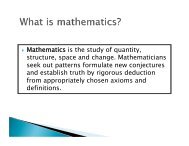View the issue here. - The Gordon School
View the issue here. - The Gordon School
View the issue here. - The Gordon School
- No tags were found...
Create successful ePaper yourself
Turn your PDF publications into a flip-book with our unique Google optimized e-Paper software.
FACULTY SPOTLIGHT ERIC KRAVITZEric has been teaching eighth grade math andscience at <strong>Gordon</strong> for sixteen years. He is agraduate of Brown University and earned hisMaster of Arts in Teaching Ma<strong>the</strong>matics atProvidence College.Eric is an eighth grade advisor, serves as aninstructor for <strong>the</strong> Teacher Residency Programteaching a course on standards-based Ma<strong>the</strong>maticsinstruction, was <strong>the</strong> faculty Boardrepresentative and coaches <strong>the</strong> Middle <strong>School</strong>tennis team. He also teaches as an adjunctprofessor at CCRI. Eric’s wife, Samanthateaches fifth grade at <strong>Gordon</strong> and <strong>the</strong>ir childrenSophie (2nd) and Gabriel (K) are current students.What led you to <strong>Gordon</strong>?While at Brown I volunteered at Hope High<strong>School</strong> and really enjoyed it. I decided to stayin Rhode Island after Brown and was attractedto <strong>Gordon</strong>’s small class sizes, its hands-onapproach to teaching and learning and <strong>the</strong>flexibility teachers have with designing <strong>the</strong>irclassroom curriculum. I have found teachingat <strong>Gordon</strong> to be incredibly rewarding and Icontinue to enjoy <strong>the</strong> relationships I have withmy students and <strong>the</strong>ir families.How do you include a multiculturalperspective in your practice?Multicultural teaching to me is just good teaching.It is important to understand <strong>the</strong> student asan individual, embrace <strong>the</strong>ir perspectives andincorporate <strong>the</strong>m into <strong>the</strong> classroom curriculumand employ different teaching methods to meet<strong>the</strong>ir learning styles. I also find that developingcurriculum with a real world context allowsstudents to make personal connections to <strong>the</strong>material <strong>the</strong>y are learning which fosters <strong>the</strong>irunderstanding and engagement.What are some examples of your math andscience curriculum that have a multiculturalperspective?<strong>The</strong> eighth grade service learning projectallows opportunities for students to connect<strong>the</strong>ir Algebra classes to <strong>the</strong> information <strong>the</strong>yare learning about in <strong>the</strong>ir service learningplacements.Every year, <strong>the</strong> eighth graders have <strong>the</strong> opportunityto experience first hand <strong>the</strong> agencies,schools and individuals that help o<strong>the</strong>rs createchange and growth in <strong>the</strong> Rhode Island. Whilein <strong>the</strong>ir placement <strong>the</strong>y are asked to reflect on<strong>the</strong> population <strong>the</strong> agency serves and identify<strong>the</strong> <strong>issue</strong>s at hand (hunger, poverty, languagebarriers, unemployment, etc.).<strong>The</strong>y use <strong>the</strong>ir algebraic knowledge to ga<strong>the</strong>rreal world data, find relationships and represent<strong>the</strong>ir findings through algebraic equations andgraphs. <strong>The</strong> students present <strong>the</strong>ir findingswhich always results in a meaningful classdiscussion about race, class and gender.In science we do an in-depth, hands-on studyof water including looking at <strong>the</strong> distribution,uses and importance of water personally,locally and globally. We specifically focus on<strong>the</strong> water around <strong>Gordon</strong>’s campus and <strong>the</strong>unit begins with students mapping out <strong>the</strong>school’s water resources (<strong>the</strong> stream and <strong>the</strong>pond).Once <strong>the</strong> maps are completed <strong>the</strong> studentstake weekly samples and test <strong>the</strong>m for salinity,conductivity, nitrate, alkalinity, pH, dissolvedoxygen, temperature and transparency.Students learn <strong>the</strong> importance of measurement,precision and accuracy, testing hypo<strong>the</strong>sesand identifying and controlling variables.At <strong>the</strong> end of <strong>the</strong>ir study, <strong>the</strong> students compile<strong>the</strong>ir data using <strong>the</strong>ir algebraic skills and sendit to www.globe.gov, as do students from overone hundred o<strong>the</strong>r schools. This shared dataallows students and researchers to performstudies that reach far beyond <strong>the</strong>ir ownbackyards.We also discuss <strong>the</strong> way <strong>the</strong> environmentaffects <strong>the</strong> quality of water and how certaincountries and areas of <strong>the</strong> world have limitedsupplies of water and what that means in termsof access and quality.What do you hope for your students?I hope that my students are confident with who<strong>the</strong>y are when <strong>the</strong>y leave <strong>Gordon</strong> and that <strong>the</strong>ycontinue to be thoughtful and caring citizens.7









